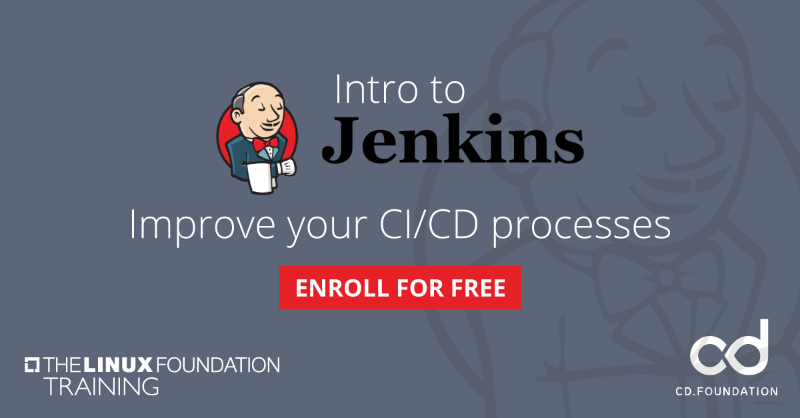Linux Foundation Training and Continuous Delivery Foundation launched a free training course on the edX platform, LFS167x – Introduction to Jenkins, on June 4. In that time, the course has already enrolled 5,000 students, making it one of the fastest-growing courses we have ever released. This is great news for helping to grow the Jenkins and overall DevOps communities.
The course covers the fundamentals of continuous integration/continuous delivery (CI/CD), and how they help transform the overall software delivery process. It is most useful for roles such as DevOps engineers, software developers and architects, and professionals focused on site reliability and quality assurance, though anyone involved in the software delivery process will benefit. It includes a detailed introduction to the Jenkins automation server, and also provides instructions on how to set up/use Jenkins for CI/CD workflows.
Upon completion, enrollees will have a solid understanding of the role that Jenkins plays in the software development lifecycle, how to install a Jenkins server, how to build software with it, how to manage third party integrations/plugins and how to scale and secure Jenkins. They will also get a glimpse of what they can do to further enhance their CI/CD skills.
Join the more than 5,000 individuals who have started improving their software delivery processes – enroll for free today!
Originally published by Oleg Nenashev on the Jenkins blog.
On behalf of the Jenkins User Experience, Documentation and Advocacy and Outreach special interest groups, we are happy to announce the online UI/UX hackfest on May 25-29! Everyone is welcome to participate, regardless of their Jenkins development experience.
The goal is to get together and work on improving Jenkins user experience, including but not limited to user interface and user documentation. We also invite you to share experiences about Jenkins and to participate in UX testing. The event follows the Jenkins is the Way theme and the most active contributors will get special edition swag and prizes!

Event plan
This hackfest is NOT a hackathon. We do not expect participants to dedicate all their time during the event timeframe, but hop-in/hop-out as their time allows. Everybody can spend as much time as they are willing to dedicate. Spending a few days or just a few hours is fine, any contributions matter regardless of their size. Jenkins development experience is not required, we have newcomer-friendly stories for those who want to start contributing to the project. We will also have a 24/7 jenkinsci/hackfest Gitter chat for Q&A and coordination between contributors.
There will be 3 main tracks:
- User Interface – Improve look&feel and accessibility for Jenkins users, work on new read-only interface for instances managed with configuration as code, create and update Jenkins themes, and many other topics. This track is coordinated by the UX SIG.
- User Documentation – Improve and create new user documentation, tutorials and solution pages. Also, there is ongoing documentation migration from Wiki to jenkins.io and plugin repositories. This track is coordinated by the Documentation SIG.
- Spread the word – Write user stories for Jenkins Is The Way site and the Jenkins blog, post about your Jenkins user experience and new features, record overview and HOWTO videos, etc. This track is coordinated by the Advocacy and Outreach SIG.
We are working on publishing project ideas and issues for the listed tracks. The current list can be found on the UI / UX hackfest event page, this list will be finalized by the beginning of the hackfest. You are welcome to propose your own projects within the User Experience theme.
During the event, we will organize online meetups and ad-hoc training sessions in different timezones. All these sessions will be recorded and shared on our YouTube channel. There are no mandatory sessions you must attend, you are welcome to join ones remotely or watch the recordings. After the event we will invite participants to demo their projects at online meetings or recorded sessions.
Registration

P.S: Note that the registration form has a question top 3 things we could change in Jenkins to improve your user experience. We would appreciate your response there!
Contacts
Please use the following contacts to contact organizers:
Resources
- Event Page
- Registration form.
- Project ideas (work-in-progress). The full list will be published by the beginning of the event.
- Frequently Asked Questions
- Contributing to Jenkins
- Code of Conduct
Swag and Prizes
Thanks to our sponsors (CloudBees, Inc. and Continuous Delivery Foundation), we are happy to offer swag to active contributors!
- 50 most-active contributors will get an exclusive “Jenkins Is The Way” T-shirt and stickers
- Active contributors will get Jenkins stickers and socks
- We are working on special prizes for top contributors, to be announced later



Acknowledgements
We thank all contributors who participate in this event as committers! We especially thank all reviewers, organizers and those who participated in the initial program reviews and provided invaluable feedback. In particular, we thank User Experience, Documentation and Advocacy and Outreach SIG members who heavily contributed to this event.
We also thank sponsors of the event who make the swag and prizes possible: CloudBees, Inc. and Continuous Delivery Foundation (CDF). In addition to swag, CloudBees donates working time for event hosts and reviewers. CDF also sponsors our online meetup platform which we will be using for the event.

The CD Foundation has joined the list of organizations participating in Google’s Summer of Code (GSoc) this year. GSoC is an annual program aimed at bringing more student developers into open source software development. The CD Foundation projects Spinnaker and Screwdriver joined long-time participant Jenkins in providing mentors for a number of projects for students interested in continuous delivery and software pipeline infrastructure.
In total, 7 Jenkins projects, 2 Spinnaker and 1 Screwdriver project were accepted in this summer’s program. Mentors from many different organizations around the world are pitching in, including CD Foundation ambassadors.
“The CD Foundation is dedicated to supporting open source continuous delivery projects worldwide. Part of that mission includes supporting and encouraging the next generation of talented developers worldwide, said Tara Hernandez, Senior Engineering Manager, Google Cloud Platform and CD Foundation Technical Oversight Committee member. “Thank you to the students and mentors who work tirelessly to create and innovate for the GSoC. We hope everyone has a fantastic time coding and learning this summer. Congratulations!”
The following is a list of the projects accepted and links to each project description and associated mentors.
Jenkin’s Projects
Loghi Perinpanayagam – Jenkins Machine Learning Plugin for Data Science
This project provides a plugin for data scientists to integrate Machine Learning Workflow with Jenkins.
Kezhi Xiong – GitHub Checks API for Jenkins Plugins
The GitHub Checks API allows developers to report the CI integrations’ detail information rather than binary pass/fail build status on GitHub pages.
stellargo – External Fingerprint Storage for Jenkins
File fingerprinting is a way to track which version of a file is being used by a job/build, making dependency tracking easy.
Rishabh Budhouliya – Git Plugin Performance Improvement
The principles of micro-benchmarking were used to create and execute a test suite which involves comparison of GitClient APIs implemented by CliGitAPIImpl and JGitAPIImpl using “average execution time per operation” as a performance metric.
Buddhika Chathuranga – Jenkins Windows Services: YAML Configuration Support
Enhance Jenkins master and agent service management on Windows by offering new configuration file formats and improving settings validation.
Zixuan Liu – Jenkins X: Consolidate the use of Apps / Addons
The main aim of the project is to consolidate Apps and Addons inside Jenkins X to avoid confusion.
Sladyn Nunes Custom Jenkins Distribution Build Service
The main idea behind the project is to build a customizable Jenkins distribution service that could be used to build tailor-made Jenkins distributions.
Spinnaker Projects
Victor Odusanya – Drone CI type for Spinnaker pipeline stage
Add Drone build type as a Spinnaker pipeline stage type.
Moki Daniel – “Continuous Delivery, Continuous Deployments with Spinnaker”
This project idea will aim at ensuring continuous delivery and continuous deployments, bringing up automated releases, undertaking deployments across multiple cloud providers, and mastering the best built-in deployments practices from Spinnaker.
Screwdriver Project
Supratik Das – Improve SCM Integration
The two key areas where Screwdriver will be improved are introduction of deployment keys for seamless handling of private repositories and triggering of builds from external SCM repositories.
Thank you to all participants! We look forward to getting updates and information on progress over the summer. For more details, please continue to visit the CD Foundation blog.
My name is Zhao Xiaojie (Rick). I’m a software engineer at Alauda, which is responsible for developing a CI/CD platform. I’m the leader of the Chinese Localization SIG and a press contact for Jenkins in China, too, where a large developer community exists invisible from the west!
I am passionate about promoting the Jenkins community and have done so in several ways, such as running Jenkins official social media channels, encouraging people to contribute tech articles, giving speeches about Jenkins at related conferences, and maintaining the Chinese Jenkins website.
I am also the author of several open source projects such as the Simplified Chinese Plugin, Jenkins CLI. And I have participated in Google Summer of Code (GSoC) twice as a mentor.
I’m a very active author and contributor in open source. I believe that CI/CD can speed business value shipping for all teams. Advocating CI/CD open source projects is an excellent way to help other teams and individuals adopt DevOps best practices. I enjoy giving public speeches or organizing meetups related to CI/CD. In my opinion, working with the CDF offers me a lot of opportunities to spread information about open source projects. The CDF ambassador program can help us to gather much more CI/CD fans.
You can find me on GitHub.

Originally posted on the Armory blog by Rosalind Benoit
Folks in the DevOps community often ask me, “I’m already using Jenkins, so why should I use Spinnaker?” We’re hosting a virtual talk to address the question! Register here to join us 3/26 and learn how Jenkins and Spinnaker cooperate for safe, scalable, maintainable software delivery.
A delivery engineer I spoke with last week said it best:
“I came from a world of using Jenkins to deploy. It’s great but, you’re just modifying Jenkins jobs. It can do a lot, but it’s like that line in Jurassic Park – ‘Your scientists were so preoccupied with whether or not they could, they didn’t stop to think if they should.’”
Many of us came from that world: we built delivery automation with scripts and tools like Jenkins, CircleCI, Bamboo, and TeamCity. We found configuration management, and used Puppet or Ansible to provision infrastructure in our pipelines as code. We became addicted to D.R.Y. (don’t repeat yourself), and there is no looking back.
Jenkins provides approachable automation of continuous integration steps. Spinnaker works with Jenkins to pick up and deliver build artifacts, and to delegate pipeline stages. As a true continuous delivery platform, Spinnaker codifies your unique software delivery culture and processes to your comfort level. It also adds production-ready value to your pipelines:
- Turnkey automation of advanced delivery strategies such as canary deployments
- One-click rollbacks
- Single pane of glass to view deployments, applications, server groups, clusters, load balancers, security groups, and firewalls
- Centralized API to automate and integrate across your toolchain
Jenkins taught us many lessons. It popularized the use of imperative pipelines to execute ordered steps in a SDLC. It taught us that centralizing delivery workflows into one platform makes strategic sense in scaling operations. At the same time, especially when used for deployments, it suffers from instability and maintenance overhead brought by unchecked plugin sprawl. It struggles to offer a scalable model for managing multiple jobs and distributed apps. But the way it consolidated SDLC tasks within a full-featured GUI empowered developer teams to start doing delivery.
In the new world of fast innovation through immutable infrastructure, Spinnaker has adapted that visibility to the realms of cloud and cloud native. It provides a centralized vantage point on all of your ephemerally-packaged applications, in their many variations. Within your pipelines, its guardrails identify invalid or non-compliant infrastructure before deployment even happens. Spinnaker’s smart delivery workflows insulate customers and end-users from impact to their software experience.
This sense of safety is Jenkins’ missing ingredient. Jenkins introduced a world where developers could independently chain together a path to production. It enabled us to improve our efficiency and code quality through testing and build automation, with self-service. This giant technological shift sparked a move away from waterfall development and ITIL-style delivery.
But, culture cannot change overnight. Developers who exercised this newfound power struck terror in the hearts of those accountable for availability and software-driven business goals. Culture lagged behind tooling, sparking fear and risk aversion. That fear still permeates many organizations, allowing baggage-free startups and the most nimble companies to digitally disrupt the status quo. These innovators prove that delivering highly valued interactions through software means increased profit and influence. Enter Armory Spinnaker.
Watch Armory CTO Isaac Mosquera’s Supercharge Your Deployments With Spinnaker and Jenkins presentation at CD Summit, or check out the longer version with Q&A at DeliveryConf.
Stop spending time and talent knitting your toolchain together with pipeline steps that rely on brittle, expensive-to-maintain scripts and repetitive GUI fiddles! Attend “I have Jenkins; why do I need Spinnaker?” to learn more about how Spinnaker can free your developers and evolve your continuous delivery game.
